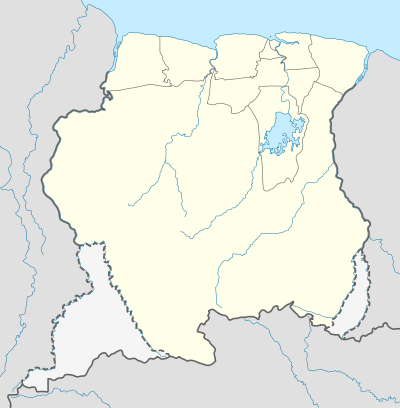Marienburg, Suriname
| Mariënburg | |
|---|---|
|
One of the old laborer housing units on plantation Mariënburg (circa 1997). | |
 Mariënburg The location of Mariënburg in Suriname. | |
| Coordinates: 5°53′N 55°1′W / 5.883°N 55.017°W | |
| Country |
|
| District | Commewijne District |
| Time zone | ART (UTC-3) |
Mariënburg is a former sugarcane plantation, factory and village, situated in the district of Commewijne, in northern Suriname.
Mariënburg was founded as a sugar plantation in 1745 by Maria de la Jaille. After several owner changes, the plantation became a coffee plantation in the 19th century. In 1882 the plantation, which had been abandoned, was purchased by the Netherlands Trading Society (NHM). The Society wanted to establish here a central sugarcane factory which had to be able to handle the surrounding plantations. To support the incoming supply of sugarcane, a 12 kilometres (7.5 mi) railway was built, the first railway in Suriname. On 23 October 1882, the cane processing factory opened. Soon after, one of the plantations dropped out, and the remaining production was not worthwhile. The NHM bought the plantations to keep the vast supplies of sugar running. On Mariënburg itself, sugarcane was also planted.
The NHM took Javanese contract workers from the then Dutch East Indies. The first Javanese workers arrived on 9 August, 1890 in Paramaribo and were brought then to Mariënburg. Indians of British India also worked on Mariënburg. On 2 July, 1902 a strike broke out among them because the NHM paid very low wages. On 29 July, director James Mavor was chased by the workers and killed, then later in the day a detachment of the Colonial Army arrived at Mariënburg. The following day, on 30 July, people were arrested, after angry workers marched to the office. Shots were then fired among a breakout of mutinous workers, resulting in 17 fatalities and 39 wounded, 7 of which later succumbed to their injuries, bringing the total number of dead workers to 24. Over a century later, on 30 July, 2006, Suriname vice president Ramdien Sardjoe unveiled a monument at Mariënburg in memory of the uprising and resulting dead, under the initiative of the Fallen Heroes Foundation of 1902.
The factory closed in 1986, and the factory and its associated buildings are now a tourist attraction, despite the dilapidated state in which the site rests in. Until its closure, Mariënburg was a publicly owned company and legally, the ex-workers were never officially fired. They live in poverty in the slums of the former laborers dwellings.

